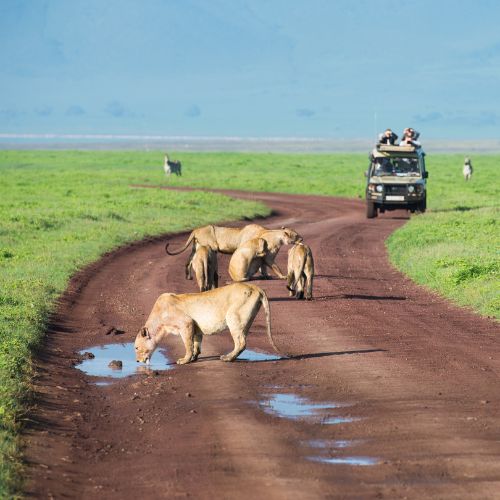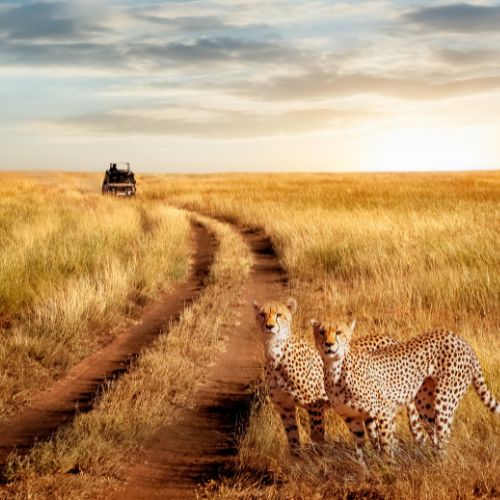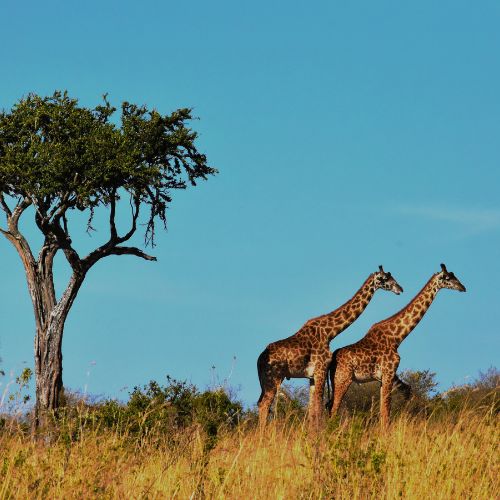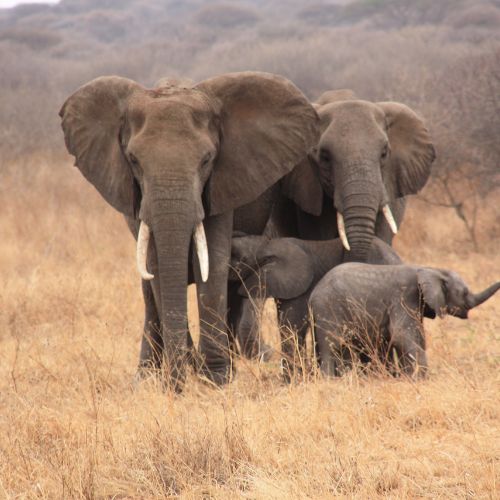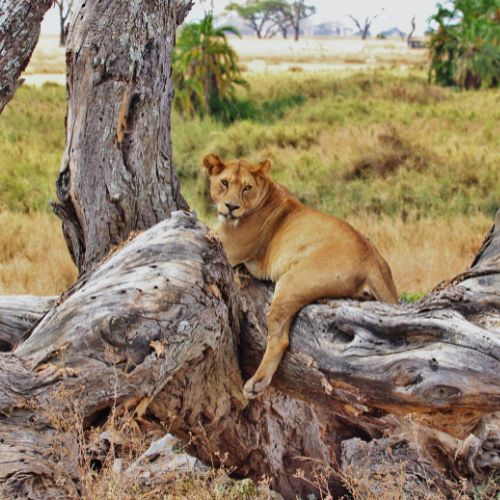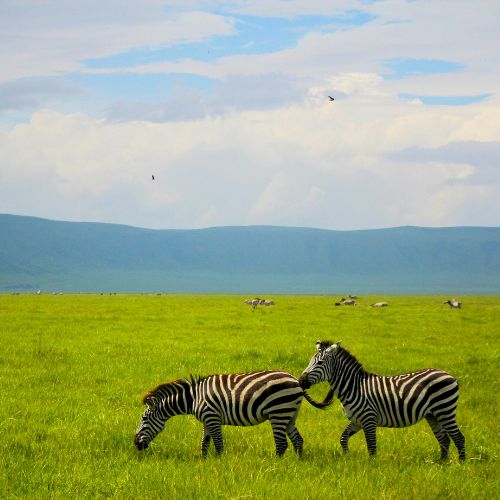4 Days - Touch of Wilderness Mid-Range
TICKETS
HOTELS
GUIDE
FOOD
PARK ENTRY
VEHICLE
Tour Overview
On this 4 Day Mid Range Safari Escape: Embrace Nature’s Beauty, we will be well looked after and afforded the opportunity to see some of the best that Tanzania has to offer. We’ll experience breathtaking wildlife in the midst of some of the most diverse landscapes; monkeys in the forest, lions in trees, elephants amongst the acacias, and a huge variety of animals inside a collapsed volcano. Not only will we visit Serengeti and Ngorongoro crater but also drive into the world-famous Lake Manyara NP mainly famous for its Tree-climbing lions.
Day-by-Day Itinerary
Arrival
After breakfast, you will venture towards the fertile highlands where wheat and corn are grown by the Iraqw people. Along the way, we’ll pass through the mist-shrouded rainforests of the Ngorongoro Conservation Area where you might be lucky enough to see baboons or even leopards and elephants in the dense undergrowth. Passing through the Ngorongoro Conservation Area, you will be able to see the breathtaking Ngorongoro Crater before travelling onwards to the Serengeti National Park, which you will reach by midday. The Serengeti National Park is the largest park in Tanzania with diverse landscapes and habitats, such as grassy plains, swamps, lakes, savannahs, and mountains. After an extensive game drive, you will drive to your accommodation where you will enjoy dinner and an overnight stay.
➔ Main Destination: Serengeti National Park
➔ Accommodation: Embalakai tented Campsite-located inside Central Serengeti
➔ Meals & Drinks: All meals included. All drinks (Except for spirits/liquor).
Day 1 - Lake Manyara National Park
You’ll be picked up from your hotel at 8 am and start a beautiful journey across the Great Rift Valley for a full day game drive. Although small in dimension (205 sq miles), the park has breathtaking scenery and is well famous for its lush acacia forest, giant figs and mahogany trees, as well as to a growing population of baboons and blue monkeys. Permanent residents of this park include giraffes, elephants, impalas and a huge number of buffaloes. The lake is also home to a large number of hippos. The landscapes of Lake Manyara are something that can not be described with words, and the game drives along the lake provide stunning photo opportunities. You have giraffes and buffaloes in the foreground and the lake in the background. Some extra tours are possible, including a bike tour or a boat excursion. In the afternoon, return to the camp for dinner. Possibility to upgrade your accommodation level. NOTE: You can replace this park with Tarangire NP or add an extra day and visit both..
➔ Main Destination: Lake Manyara National Park
➔ Accommodation: Marera Valley lodge
➔ Meals & Drinks: Mealsand Drinks included.
Day 2 - Serengeti National Park
After an early breakfast, depart towards the most famous national park in the world, the Serengeti. The driving itself, although long, is spectacular. This will be an unforgettable moment for anyone seeing it for the first time. As you progress well into the Serengeti, you will see why the name means, in local language, “endless plains”. The park has 6,900 sq miles (18,000 sq km) and for most of it, the plains will stretch to the horizon defying your senses and perception of distances. It is the home of the Great Migration and to 2 million wildebeests, hundreds of thousands of zebras and all kinds of antelopes. As for big cats and large predators, it’s the place of choice to look out for lions, cheetahs, leopards, hyenas, with many television scenes like the famous River Crossings having been filmed in this park. Possibility to upgrade your accommodation level..
➔ Main Destination: Serengeti National Park
➔ Accommodation: Embalakai Authentic lodge located inside Central Serengeti
➔ Meals & Drinks: All meals included. All drinks (Except for spirits/liquor).
Day 3 - Serengeti National Park - Ngorongoro Crater
On this day, we will suggest a very early wake-up call in order to do an early morning game drive (when the animals are more active) and to see one of the best sunrises you’ll ever witness. After the game drive, we’ll return to the camp for a rewarding brunch, and then we’ll proceed to Ngorongoro, the 8th Wonder of the Natural World. The crater spreads for 102 sq miles and has 2,000 ft high walls, making it virtually Noah’s ark and inhabiting almost every species of wildlife that is indigenous to East Africa. It’s one of the very rare locations in the whole continent where you can witness the black rhino. The crater has a river, several swamps, a soda lake with a great concentration of flamingos, a forest and open plains. It’s also famous for its elephants which, are the largest in the world and have huge tusks. Ngorongoro Crater is truly a Wonder of the Natural World. You will reach Ngorongoro in time for a sundowner. There is a possibility to upgrade your accommodation level..
➔ Main Destination: Serengeti National Park
➔ Accommodation: Pakulala Safari Camp located on the Ngorongoro crater rim
➔ Meals & Drinks: All meals included. All drinks (Except for spirits/liquor).
Day 4 - Ngorongoro Crater
We will start the day very early and descend into the crater floor for an incredible morning of wildlife in one of the most stunning places on earth. After the game drive, there will be time for a picnic lunch near the beautiful Hippo Lake. After lunch, we will have time for a short game drive and then ascend the crater and exit Ngorongoro Conservation Area towards Arusha. We expect to be back in Arusha at around 5 pm although we are flexible in case there is a flight to catch or another situation..
➔ Main Destination: Arusha
➔ Accommodation: No Accomodation
➔ Meals & Drinks: Bed and Breakfast
End of tour
➔ Additional accommodation can be arranged for an extra cost.
➔ You’ll be dropped off at the airport.
Tour Price Inclusion and Exclusion
- Park fees
- All activities (unless labeled as optional)
- All accommodation as stated in the itinerary
- A professional driver/guide
- All transportation (unless labeled as optional)
- All Taxes/VAT
- Roundtrip airport transfer
- All Meals (as specified in the day-by-day section)
- International flights (from/to home)
- Additional accommodation before and at the end of the tour
- Tips (tipping guideline US$10.00 pp per day)
- Personal items (souvenirs, travel insurance, visa fees, etc.)
- Government imposed increase of taxes and/or park fees
- Alcohol drinks

